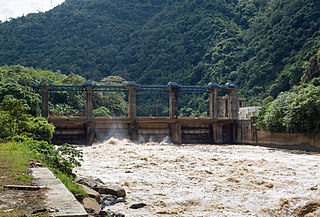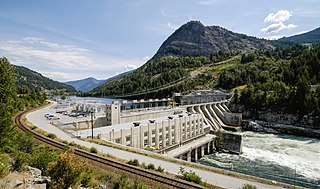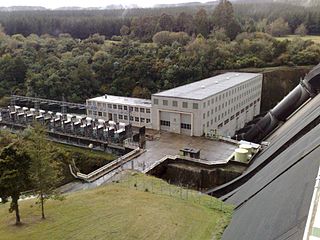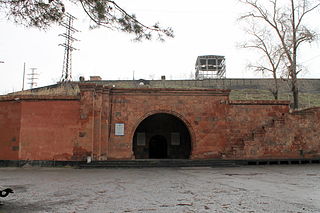
Small hydro is the development of hydroelectric power on a scale suitable for local community and industry, or to contribute to distributed generation in a regional electricity grid. Exact definitions vary, but a "small hydro" project is less than 50 megawatts (MW), and can be further subdivide by scale into "mini" (<1MW), "micro" (<100 kW), "pico" (<10 kW). In contrast many hydroelectric projects are of enormous size, such as the generating plant at the Three Gorges Dam at 22,500 megawatts or the vast multiple projects of the Tennessee Valley Authority.

Hydroelectricity, or hydroelectric power, is electricity generated from hydropower. Hydropower supplies one sixth of the world's electricity, almost 4,500 TWh in 2020, which is more than all other renewable sources combined and also more than nuclear power. Hydropower can provide large amounts of low-carbon electricity on demand, making it a key element for creating secure and clean electricity supply systems. A hydroelectric power station that has a dam and reservoir is a flexible source, since the amount of electricity produced can be increased or decreased in seconds or minutes in response to varying electricity demand. Once a hydroelectric complex is constructed, it produces no direct waste, and almost always emits considerably less greenhouse gas than fossil fuel-powered energy plants. However, when constructed in lowland rainforest areas, where part of the forest is inundated, substantial amounts of greenhouse gases may be emitted.

Tenaga Nasional Berhad, also known as Tenaga Nasional or simply Tenaga, is the Malaysian multinational electricity company and is the only electric utility company in Peninsular Malaysia and also the largest publicly listed power company in Southeast Asia with MYR 182.60 billion worth of assets. It serves over 10.3 million customers throughout Peninsular Malaysia and the East Malaysian state of Sabah through Sabah Electricity Sdn Bhd.

The Bakun Dam is an embankment dam located in Belaga District, Kapit Division, Sarawak, Malaysia, on the Balui River, a tributary or source of the Rajang River and some sixty kilometres east of Belaga. As part of the project, the second tallest concrete-faced rockfill dam in the world would be built. It would generate 2,400 megawatts (MW) of electricity once completed.

The Murray Region Hydroelectric Power Stations refers to two of the original seven hydroelectric power stations, both located near the town of Khancoban in the Snowy Mountains region of New South Wales, Australia. The two power stations are part of the Snowy Mountains Scheme, a vast hydroelectricity and irrigation complex constructed in south-east Australia between 1949 and 1974 and now run by Snowy Hydro. Although both power stations are physically located in New South Wales, since 1 July 2008 all power generated has been allocated to the Victorian region of the National Electricity Market. The stations are not located on the Murray River.

The Robert Moses Niagara Hydroelectric Power Station is a hydroelectric power station in Lewiston, New York, near Niagara Falls. Owned and operated by the New York Power Authority (NYPA), the plant diverts water from the Niagara River above Niagara Falls and returns the water into the lower portion of the river near Lake Ontario. It uses 13 generators at an installed capacity of 2,525 MW (3,386,000 hp).
Chenderoh Power Station or Chenderoh Dam was the first major hydroelectric dam and power station in Malaysia. It was preceded by two stations on Malaya's rivers; the 800kw Ulu Gombak station in Selangor (1905) that was used to provide Kuala Lumpur's first electricity, and the Sungei Besi Tin Mines Ltd scheme at Ulu Langat that was purchased by FMS Electrical Department in 1929. The dam is located at Chenderoh Lake, Kuala Kangsar District, Perak. It was constructed by Perak River Hydro-Electric Power Company Ltd and completed in 1930. The scheme was designed by consulting engineers Rendel, Palmer & Tritton of London and Vattenbyggnadsbyran (VBB) of Stockholm, Sweden. The architect was Osvald Almqvist.

SEGESA is the national electricity company of Equatorial Guinea, with its head offices in Malabo, Equatorial Guinea. It is the sole operator of the electricity sector of Equatorial Guinea. The company was created in November 2001 by a merger of the national rural electrification company SONER and the national electricity corporation ENERGE. In 2013 the company was reorganized into three units: SEGESA Comercial for distribution and sales, SEGESA Generación for generation activities and SEGESA Transmisión for transmission. The three units are overseen by SEGESA Holding.
Pergau station, formally known as Stesen Janaelektrik Sultan Ismail Petra, is a hydroelectric power station in Kuala Yong, Kelantan, Malaysia.

Run-of-river hydroelectricity (ROR) or run-of-the-river hydroelectricity is a type of hydroelectric generation plant whereby little or no water storage is provided. Run-of-the-river power plants may have no water storage at all or a limited amount of storage, in which case the storage reservoir is referred to as pondage. A plant without pondage is subject to seasonal river flows, so the plant will operate as an intermittent energy source. Conventional hydro uses reservoirs, which regulate water for flood control, dispatchable electrical power, and the provision of fresh water for agriculture.

Tenom Pangi Dam is a hydroelectric plant in Tenom, Sabah, Malaysia. It is located 120 km (75 mi) south of Kota Kinabalu on the Padas River. The project is a run-of-river hydroelectric power plant. Tenom Pangi Dam is the only major hydroelectric dam in Sabah.

Brilliant Dam is a hydroelectric dam on the Kootenay River near Castlegar, British Columbia, Canada. It was built during the Second World War, mostly by Doukhobour men exempt from military service, and its 129 MW twin turbines first came into operation in June, 1944. The Columbia Power Corporation purchased the dam from Teck Cominco in 1996.

The Murum Dam is a gravity dam on the Murum River in Sarawak, Malaysia. Construction began in 2008, the dam's reservoir began to fill in July 2013 and the first generator was commissioned in December 2014. The fourth and final turbine bcame operational on 8 June 2015. Concerns have been raised about the displacement of the Dayak people and the removal of rainforest due to the construction of the dam.

Whakamaru Power Station is a hydroelectric power station on the Waikato River, in the North Island of New Zealand. It is the fourth hydroelectric power station on the Waikato River.

Sơn La Dam is a concrete gravity dam on the Black River in Ít Ong, Mường La District, Sơn La Province, Vietnam. It is the largest hydroelectric power station in Southeast Asia.

The Koyna Hydroelectric Project is the second largest hydroelectric power plant in India, just after the Tehri Dam Project. It is a complex project with four dams including the largest dam on the Koyna River, Maharashtra, hence the name Koyna Hydroelectric Project. The project site is in Satara district.

Sarawak Energy is the state owned electric utility company of the State of Sarawak. It is one of Malaysia's three electrical companies, the other two being Tenaga Nasional serving Peninsular Malaysia, and Sabah Electricity which serves the state of Sabah and territory of Labuan.
Kudgi Super Thermal Power Station is a power station located at Kudgi village of Basavana Bagewadi Taluq in Bijapur district, Karnataka in Indian state of Karnataka. This is one of the coal based thermal power plants of NTPC Limited.

Sevan–Hrazdan Cascade is a complex of hydroelectric power plants on the Hrazdan River and its tributaries between the Lake Sevan and Yerevan in Armenia. They use irrigation water flow from the Lake Sevan and streams waters of Hrazdan River. The cascade is owned by the International Energy Corporation (IEC), a subsidiary of Tashir Group owned by Samvel Karapetyan.

















